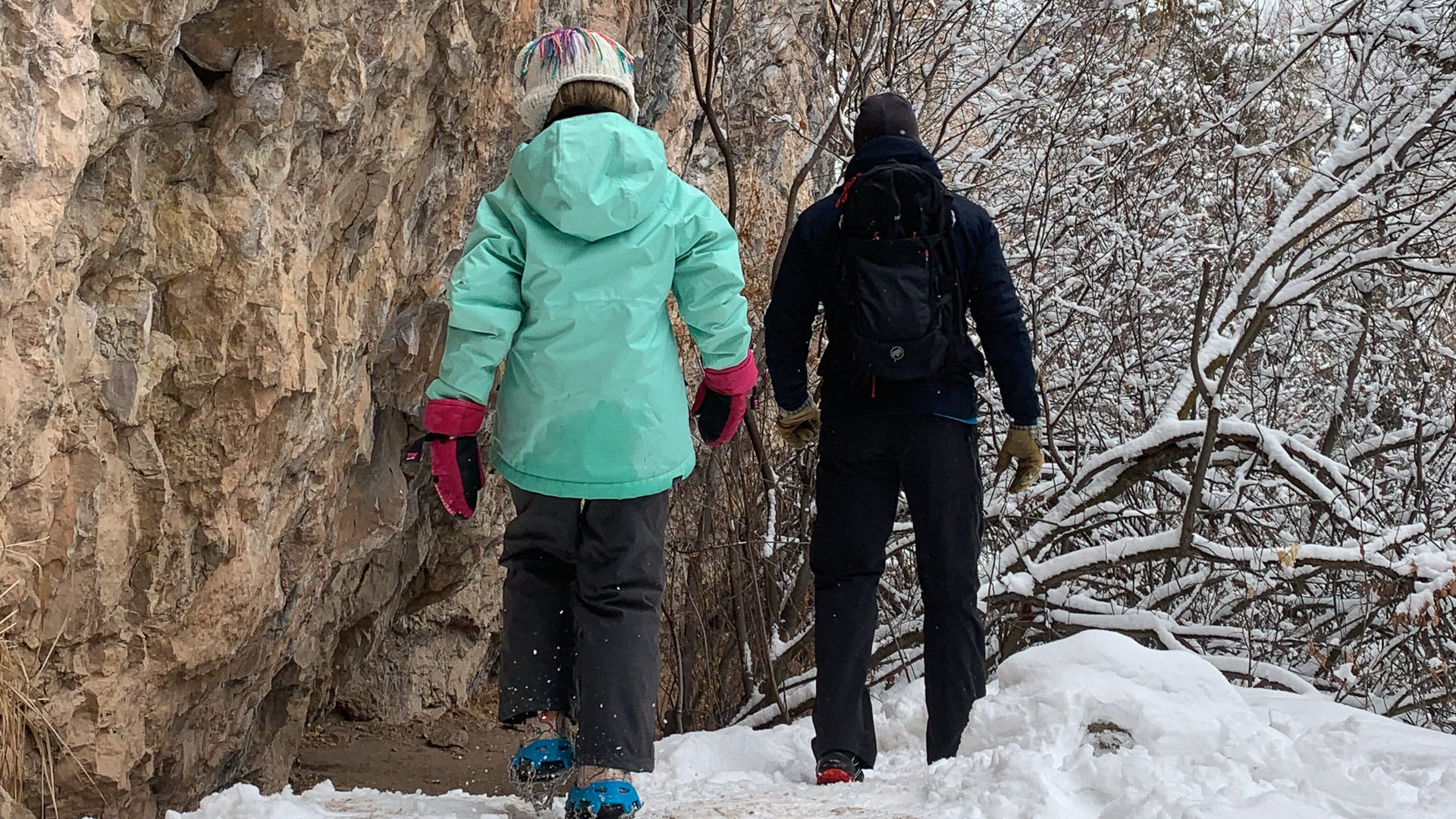
Despite the cold temperatures, the frozen ground and the trees being barren, winter is a magical time to lace up your hiking boots and head out for a hike. With a few more precautions, a few more layers and a few more steps in planning, you can enjoy hiking year-round. These seven tips will help you make the most of your winter hiking excursions.

Pack The 10 Essentials
Whether you are hiking in December or May, these 10 essentials should be in your pack to be prepared for a safe hike from start to finish.
- Navigation tools (compass and map, GPS device)
- First aid (especially foot care)
- Headlamp and extra batteries
- Knife and repair kit (duct tape, etc.)
- Sunblock, sunglasses, etc.
- Shelter
- Lighter, matches, stove, tinder
- Extra water
- Extra food
- Extra clothing (socks, gloves, extra layers)
Other considerations include avalanche safety gear, snowshoes or spikes and other items needed to have a safe hike in the winter.

Have The Right Gear
It goes without saying that part of staying safe while winter hiking is having the right gear. Check the trail conditions prior to heading out on your hike. Depending on recent weather, you may be able to just hike in waterproof boots. Gaiters are a great idea for keeping snow out of your boots.
Some trails may require spikes if there are icy conditions. If there is fresh snow on the ground, or the terrain is hilly, snowshoes may be the best choice, especially if you have to break trail. Trekking poles can add a bit more stability and balance.
Just like with all winter activities, layers are your friend. Have a wicking insulating layer followed up by a mid layer and waterproof shell. Pack an extra pair of socks in your pack along with extra gloves and a hat, as suggested under 10 Essentials.
If you are headed into avalanche territory, you must carry additional equipment. Be prepared with a shovel, probes and beacon.

Focus On Safety
Be weather aware when heading out for a winter hike. Watch the weather forecast to be sure you are prepared for the hike. If you are headed to avalanche territory, check out the current risk at Avalanche.org. Trail reports are great to check on sources like All Trails. You can also check the website and social media platforms for the area you are hiking in to see what trail conditions are and if certain trails are closed.
Be cognizant of the trail you are hiking and the distance, as it will take longer to hike that same distance in the winter. Daylight hours are shorter, as well, making it important to make the most of the sun. If you are new to winter hiking, choosing a shorter trail is a good place to start.
Know the terrain you will be encountering, the mileage and other trail tidbits before you head out on the trail. A trail that gets good sun coverage may be slippery and icy early in the day and mushy toward the end of the day. If part of the trail is west facing, the trail will be shady for longer, with hard-packed snow and ice.
Be ready for changing conditions based on the trail and current weather. Snow can hide trail markers and the trail, so having a navigation tool and being familiar with the trail you are hiking is essential. It’s always OK to cut a hike short if the trail conditions become dangerous or if someone is cold.
Especially in the winter, it is always safest to hike with a friend or family member. It’s a good idea to let someone know where you are hiking and the approximate time you will be home, no matter what season it is.

Have Those Eyes And Ears Open
Listen for unusual sounds like trees cracking or crashing down, boulders knocking together or ice cracking. A roaring sound could be a potential warning of a slide or avalanche. Always watch for hazards on the trail, like downed branches, patches of ice, water or deep snow. As mentioned above, trail conditions will most likely change throughout the hike, based on sun exposure and other factors.
Also, watch for signs of hypothermia within yourself and anyone else in your hiking party. Common warning signs are shivering, confusion, exhaustion, fumbling hands and slurred speech. Take action right away if any of these warning signs occur by removing wet clothing and getting the person warm and out of the cold and providing them medical attention as needed.
Frostbite is an additional concern while winter hiking. Tingling, numbness and stiffness of skin are all signs. Red or darkened skin is also a warning sign. Remove wet clothes and replace them with dry, warm clothes. Get the person warm and out of the cold and administer/get medical attention as needed.

Keep Hydration And Nutrition In Check
Just because the temperature isn’t high or the sun isn’t out doesn’t mean that you don’t need to be on top of hydration and nutrition. You will most likely work up quite a sweat (hence the need for a wicking base layer) while you are making your way through the snow.
Be sure to take sips of water along the trail. If you are worried about your water freezing, place your hydration pack close to your body under your shell. Add a little electrolyte powder (many companies make seasonal flavors, including apple cider and hot cocoa) to your water to encourage hydration. Dehydration can lead to hypothermia. If you feel thirsty, you are already dehydrated!
Pack snacks to munch on along the way, including seasonal flavored energy bars, nut mixes or your favorite trail snack. The best snacks to pack are ones that you don’t have to stop to eat and/or take your gloves off to handle.
Don’t forget to have a warm drink waiting in the car, and extra food, too. This will make the drive home more pleasant while making sure your body has the fuel it needs.

Keep Moving
One of the best winter hiking tips is to always keep moving. Stopping a lot on the trail will not only bring the heart rate down, but it will lead to opportunities for the cold to set in. As previously mentioned, hiking a trail in winter will take approximately double the time based on trail conditions. Choosing trails with some elevation gain will help you keep your body moving.
Packing high-calorie snacks you can eat on the move (without having to remove your gloves) is wise to keep the body moving. The less exposure to the cold you can give your extremities, including your hands, the better.

Enjoy The Change Of Scenery
Less crowded trails, abundant silence and different views all await you while winter hiking. It’s amazing how different a trail can look when it is covered in snow, and you won’t have to deal with bugs or bears, either. Take the opportunity to beat the winter blues while searching for animals that you can see in the winter, including the arctic fox, snow owl and snowshoe hare. Hunting for animal tracks in the snow is also a fun activity. Winter offers fantastic photography opportunities, too. The added bonus of hiking in the winter is that you will burn more calories and build more muscle, all while enjoying a wintery trail.





